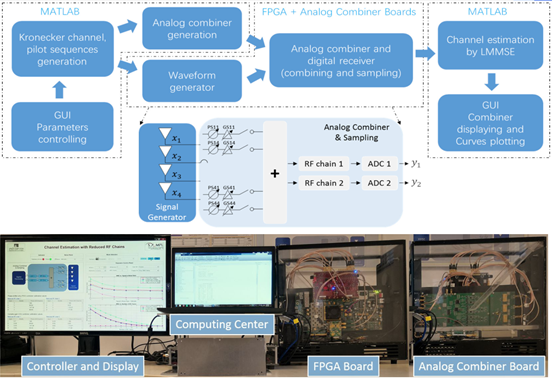
Information flow diagram of the hardware prototype (upper) and the real tiems picture (lower). (Photo by GONG Tierui)
In recent years, to increase the capacity of wireless communication systems, alleviate the shortage of available spectrum resources, and increase the transmission rate of communication data, the massive Multiple-Input Multiple-Output (MIMO in short) technique equipped with a large number of antenna arrays, as well as the millimeter-wave communication technique using high-frequency spectrum resources have gradually become important enablers to the fifth generation mobile communications (5G).
The traditional approach, under which one RF chain is equipped to each antenna, can face huge power consumption and high cost especially when working in the millimeter-wave bands. It is thus of great significance to study the RF chain reduction technique for millimeter-wave massive MIMO systems to promote the deployment of 5G.
However, existing works only consider the use of instantaneous channel state information, which leads to extremely high configuration complexity. In addition, the previous works are further affected by the quantization accuracy of wireless channels, resulting in a large performance loss.
Recently, the Industrial Communication and System-on-Chip (iComSoC) Group at Shenyang Institute of Automation (SIA), Chinese Academy of Sciences (CAS), and the Signal Acquisition, Modeling, Processing and Learning (SAMPL) Lab at Weizmann Institute of Science in Israel, have jointly proposed theory and algorithm on RF chain reduction for wireless MIMO communication systems, and successfully built up the hardware prototype. Their study was published onIEEE Systems Journal.
The researchers first configured a hardware network using the second-order statistics of wireless channels, which can significantly reduce the complexity of hardware configuration. Taking channel estimation as the optimization criterion, they derived the optimal solution for fully-connected complex gain hardware networks under noisy conditions.
Meanwhile, they proposed a high performance iterative alternating optimization algorithm for fully-connected phase shifter hardware networks, by exploiting multiple degrees of freedom of optimization variables. Furthermore, they built a hardware prototype to realize the relevant theory and algorithm, and verified the correctness in the actual environment.
This work provides an effective solution for the deployment of 5G.
Contact:
GONG Tierui
Email: gongtierui@sia.cn